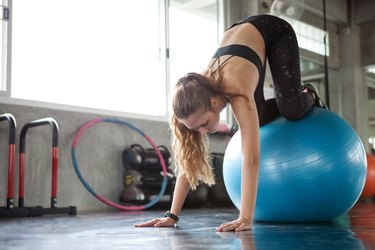
Six-pack abs are arguably the most desired physical feature for fitness enthusiasts. And except for the rare case, six-pack abs are visual proof of dedicated exercise and sound nutrition. But there's one addition to the classic six-pack that takes your body to the next level: A V-cut stomach — the hallmark of a lean, athletic physique.
To build it, you'll need to dedicate your nutrition and stay in a caloric deficit. Then, you'll need to exercise with compound exercises, as well as specific ab work, to add the finishing touches. With consistent hard work, a V-cut stomach can be yours.
Video of the Day
Video of the Day
What Is a V-Cut Stomach?
The V-cut is the product of low body fat and dense ligaments that mark the barrier of your rectus abdominis, or your six-pack, muscles. To optimize your ab development and get a V-cut stomach, you need very low body fat, often between 4 and 7 percent, and well-developed, muscular abs.
How to Lower Your Body Fat
Lowering your body fat requires a dual attack with both your diet and exercise routine. Still, the cliche that "abs are made in the kitchen" rings true. Your best bet for fat loss is eating fewer calories than you're burning. Track your calories with an app.
Counting calories alone isn't enough if you don't focus on healthier food choices. A focus on high-quality foods, while decreasing consumption of lower-quality foods, is an important factor in helping you consume fewer calories.
Therefore, make it your focus to eat more unrefined and minimally processed foods. Lean protein, such as fish and chicken; fruits and vegetables; and healthy fats, like raw nuts, make up most meals. The, decrease the amount of processed food you eat, including sweetened drinks, fried foods and refined snacks.
Exercise for Fat Loss
Resistance training should emphasize compound lifts, like dead lifts, squats, pullups and lunges, as the foundation of your training. Training for strength with big movements stimulates the largest muscles in your body to release anabolic hormones, like testosterone and growth hormone, both of which aid in burning body fat and stimulating muscle growth.
Then according to the American College of Sports Medicine, as much as 150 to 250 minutes per week of moderate-intensity physical activity is necessary for weight loss. That equates to three resistance training workouts of 45 minutes and three 30-minute aerobic workouts, such as biking, per week.
Read more: The Cardio Abs Workout
Direct Ab Training
To maximize the definition and development of your V-cut stomach, it's important to train your abs. Stronger, more muscular abs create deeper separations between the two halves of the rectus abdominis muscle, helping your abs remain visible even when your body fat is a higher.
Perform one rollout variation and the hanging leg raise twice per week during your training to build dense, separated abdominal V-lines.
1. Stability Ball Rollout
HOW TO DO IT: Begin by kneeling with your elbows resting on a stability ball. Brace your abs as if you were doing a plank; then slowly extend your arms in front of your torso.
Roll out slowly until you feel the stretch in your abs, pause for one second and then roll the ball back in. Do two sets of 10 reps on the stability ball rollout. Once stability ball rollouts become easy, move on to the next exercise.
2. Ab Wheel Rollout
Ab wheel rollouts are an absolute killer for ab development. Plus, they force you to resist the arching of your lower back while also training your lats, shoulders and triceps.
HOW TO DO IT: Kneel down, holding the handles of the wheel with your arms locked out beneath your shoulders. Brace your abs and roll out as far as possible; then roll back without shifting your hips or arching your lower back.
Start small on the ab wheel with two or three sets of six to eight reps. As you improve, add two or three reps per week up to 15 reps. Then add a third set.
3. Hanging Leg Raise
The hanging leg raise is an excellent exercise for targeting the lower portion of your rectus abdominis. Unlike crunches, which focus on stimulating the upper abdominals, leg raises force the hips and lower portion of the abdominals to flex and tilt the pelvis.
HOW TO DO IT: With a double-overhand grip, hang from a pullup bar with your elbows slightly bent and shoulders retracted. Bring your legs up past 90 degrees, rolling your hips and forming an "L" shape with your body.
Pause at the top for one second; then slowly lower your legs under control to the full hanging position. If you struggle with the hanging leg raise, start by keeping your knees bent on all reps, slowly straightening your legs as you become stronger. Perform three sets of 10 to 15 reps of the hanging leg raise.
Read more: Strength Training for Losing Weight